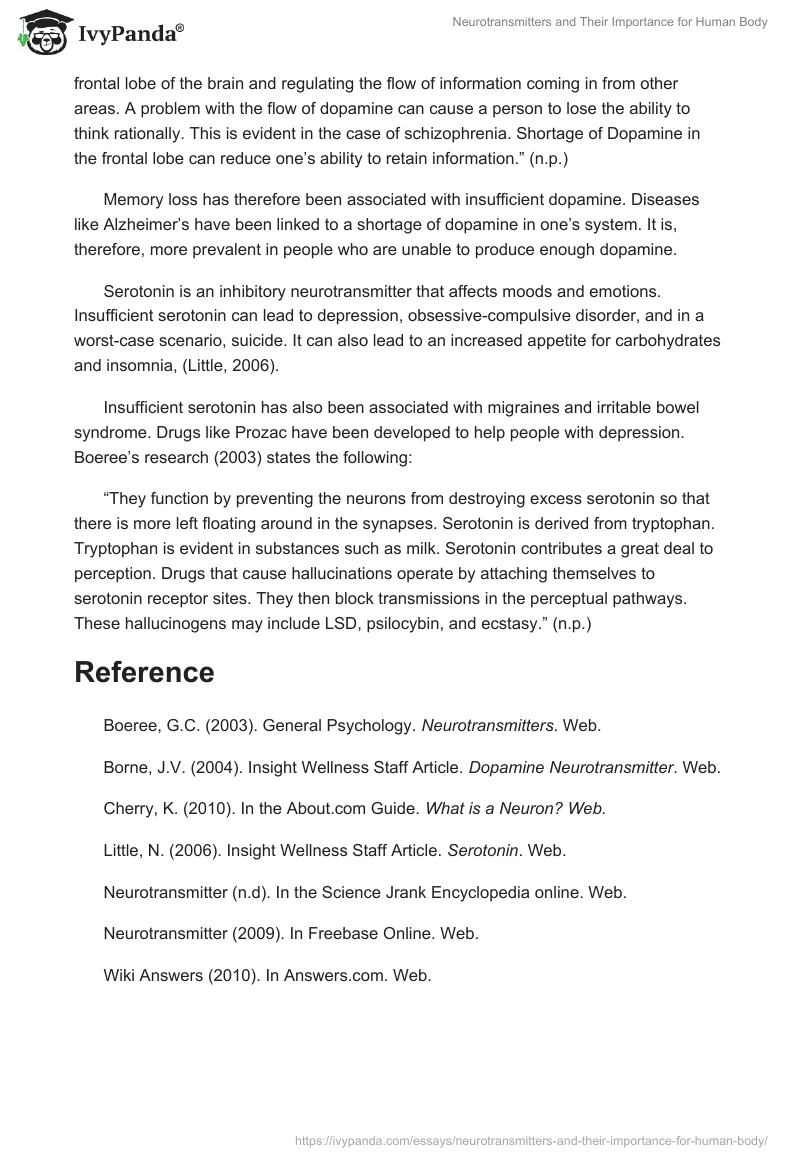Neurotransmitters are chemicals that are used by cells of the nervous system to transmit information to other cells of the body (Boeree, 2003). Neurotransmitters transmit information from the brain and spinal cord to the organs and back. They also stimulate the muscle fibers. They do this by altering their electrical state or activity.
According to the Science Jrank encyclopedia (n.d.), “anything that affects the behavior of a neurotransmitter, also affects the function of the organism”. “Neurotransmitters are responsible for conveying thoughts, emotions, planning, and other types of behavior” (Wiki Answers, 2010). According to Wiki Answers (2010), “these processes can be manipulated through the regulation of neurotransmitter signaling. This concept can be applied in the treatment of disorders such as Parkinson’s disease, Alzheimer’s, and depression”.
According to Cherry (2010), “A neuron is a nerve cell that is the basic unit of the nervous system. Unlike other cells, they are specialized to transmit information throughout the body. Neurons are responsible for transmitting information in both chemical and electrical forms.” Neurotransmitters transmit information to adjoining cells such as neurons. “Neurotransmitters also operate from the brain and spinal cord to organs of the digestive system, respiratory system, endocrine system, excretory system, etc., and back” (Wiki Answers, 2010). “Regulating neurotransmitters in the above-stated systems can aid in the control and treatment of discomforts such as nausea, vomiting, diarrhea and in some cases, panic attacks” (Wiki Answers, 2010).
“Dopamine is a neurotransmitter that deals with the control of movement, emotional responses, and the capacity to feel pain and pleasure,” (Borne, 2004). It is necessary for balanced and controlled movements. It is an inhibitory neurotransmitter. It is also associated with reward mechanisms in the brain (Freebase online, 2009). Consumption of drugs like cocaine, opium, heroin, and alcohol has been known to increase the levels of dopamine (Freebase online, 2009). Borne’s research (2004) states the following:
“Insufficient dopamine, however, can lead to a lack of controlled movements such as those experienced in Parkinson’s disease”. Dopamine operates by moving into the frontal lobe of the brain and regulating the flow of information coming in from other areas. A problem with the flow of dopamine can cause a person to lose the ability to think rationally. This is evident in the case of schizophrenia. Shortage of Dopamine in the frontal lobe can reduce one’s ability to retain information.” (n.p.)
Memory loss has therefore been associated with insufficient dopamine. Diseases like Alzheimer’s have been linked to a shortage of dopamine in one’s system. It is, therefore, more prevalent in people who are unable to produce enough dopamine.
Serotonin is an inhibitory neurotransmitter that affects moods and emotions. Insufficient serotonin can lead to depression, obsessive-compulsive disorder, and in a worst-case scenario, suicide. It can also lead to an increased appetite for carbohydrates and insomnia, (Little, 2006).
Insufficient serotonin has also been associated with migraines and irritable bowel syndrome. Drugs like Prozac have been developed to help people with depression. Boeree’s research (2003) states the following:
“They function by preventing the neurons from destroying excess serotonin so that there is more left floating around in the synapses. Serotonin is derived from tryptophan. Tryptophan is evident in substances such as milk. Serotonin contributes a great deal to perception. Drugs that cause hallucinations operate by attaching themselves to serotonin receptor sites. They then block transmissions in the perceptual pathways. These hallucinogens may include LSD, psilocybin, and ecstasy.” (n.p.)
Reference
Boeree, G.C. (2003). General Psychology. Neurotransmitters. Web.
Borne, J.V. (2004). Insight Wellness Staff Article. Dopamine Neurotransmitter. Web.
Cherry, K. (2010). In the About.com Guide. What is a Neuron? Web.
Little, N. (2006). Insight Wellness Staff Article. Serotonin. Web.
Neurotransmitter (n.d). In the Science Jrank Encyclopedia online. Web.
Neurotransmitter (2009). In Freebase Online. Web.
Wiki Answers (2010). In Answers.com. Web.


